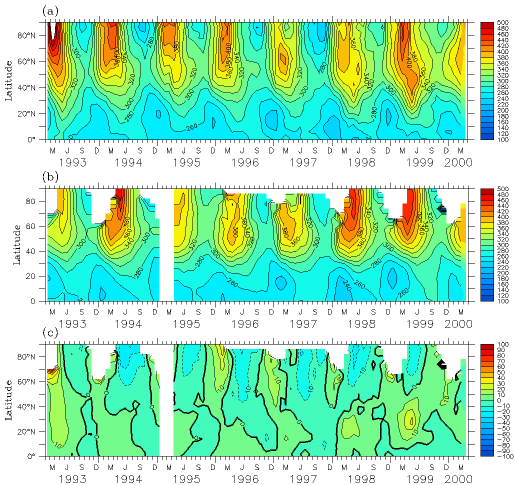
(1) Main Geophysical Observatory, 7 Karbyshev Street, 124021,
S. Petersburg, Russia
(2) Climate Research Group, Department of Atmospheric Sciences,
University of Illinois at Urbana-Champaign, 105 S. Gregory Street,
Urbana, IL 61801, USA
FIGURES
Abstract
Discovering of the ozone hole in the Southern Hemisphere (Farman et al., 1985) and later on lesser scales in the Northern Hemisphere (Brune et al., 1990) put up a problem of the ozone depletion as one of the major global scientific and environmental issue of the last century. Recent measurements of the tropospheric source gases have shown decreasing in the concentration of CFCs as has been expected according to Montreal Protocol and its Amendments restrictions (Montzka et al., 1996, Montzka et al., 1999, Engel et al., 1998, Froidevaux et al., 2000, Anderson et al., 2000). Anderson et al.(2000) pointed out that the atmosphere is becoming less chlorinated near the stratopause since the beginning of 1997. On the other hand, according to Report on the Fifth European Ozone Symposium (SPARC News, 2000) total ozone values over the Arctic in spring 1998 and 1999 were higher than in the previous few years and almost reached the amounts observed in 1980s. Accordingly, it is important to assess the benefits of the MPA and track its progress in the future (WMO, 1999, SPARC, 1998). This problem cannot be resolved on the base of an analysis of observed ozone trends alone, or by using simple models because the level of ozone in the atmosphere is controlled by many interacting processes, including chemical destruction and production, as well as the changes in temperature and circulation patterns. Even two dimensional (2D) models with enhanced photochemistry can not be used to elucidate this problem because their prescribed by most of the 2D models zonal-mean temperature and circulation does not reproduce interannual variability and does not allow to calculate correctly the appearance of PSC, the main factor which determines the ozone destruction in the high-latitude stratosphere.
One of the possible way to identify what part of the observed ozone trend can be explained by the changes in the concentrations of CFCs is to apply a 3-D Atmospheric Chemical-Transport model (ACTM) driven by assimilated circulation fields which supposed to be very close to the real meteorological situation. Such temperature and wind fields are available from the UKMO assimilation data set (Swinbank, 1994) since 1991, and it has been proven by Chipperfield (1999) that the total ozone distribution can be successfully simulated with a state-of-the-art ACTM driven by these winds.
We have estimated the contribution of Montreal Protocol and its Amendments to the modern ozone trends using the UIUC 24-layer Stratospheric Chemical Transport model (UIUC SCTM) (Rozanov et al., 1999a) driven by UKMO assimilated wind and temperature fields for the period 1993-2000. The UIUC SCTM is a global grid-point 24 level model with horizontal resolution of 40° by latitude and 50° by longitude. In the vertical direction the model extends from the Earth's surface to 1 hPa. The chemical part of the model has been updated by including the methane oxidation chain and bromine cycle which were not accounted for in the basic version (Rozanov et al., 1999a). The initial conditions for the trace gas concentrations have been taken from UARS climatological data for August 1992 (http://hyperion.gsfc.nasa.gov/Analysis/UARS/urap/home.html). The Pinatubo aerosol properties have been adopted from Stenchikov et al. (1998). The ground level concentrations of CO2, CH4, N2O, CFC-11 and CFC-12 for each simulated year have been taken from NOAA/CMDL database (http://www.cmdl.noaa.gov/hats/index.html), separately for the Northern and Southern hemispheres as a seasonal data. The surface mixing ratio of CFCs have been scaled to take into account the other sources of active chlorine. The surface fluxes of NOx and CO have been acquired from Müller et al. (1995). The same database has been used for the prescribing of NOx lightning source.
The evaluation of the UIUC SCTM ability to simulate the total ozone is presented in Figures 1 and 2. Figure 1 illustrates that the model mimics well the seasonal behavior of the total ozone over the Northern Hemisphere, the maximum is around 60-70 degree North or on-pole (it depends on the dynamics and stability of the polar vortex) usually in March and minimum in October. In the tropics the model predicts well the low total ozone values here and the minimum of total ozone during boreal winter, when the transport of ozone to the north is prevailing. The overall agreement between simulated and observed total ozone is within 10-12% over high latitudes and better than 10% in the tropics. The most noticeable disagreement is during years 1993 and 1998 when the difference is close to 20%.
 |
| Fig.1 Time-latitude cross-section of monthly zonally averaged total ozone simulated by UIUC ACTM (a) in comparison (c) with TOMS data (b). |
Figure 2 presents a comparison of the geographical distributions of the simulated and observed total ozone for the Northern Hemisphere in March 2000 and the Southern Hemisphere in October 1998 for the simulation with the actual CFC concentrations. It is seen that the model reproduces well the geographical pattern of the observed ozone distribution and its maximum and minimum values. A more detailed validation of the model is given by Rozanov et al.(1999b) and Egorova et al. (2000).
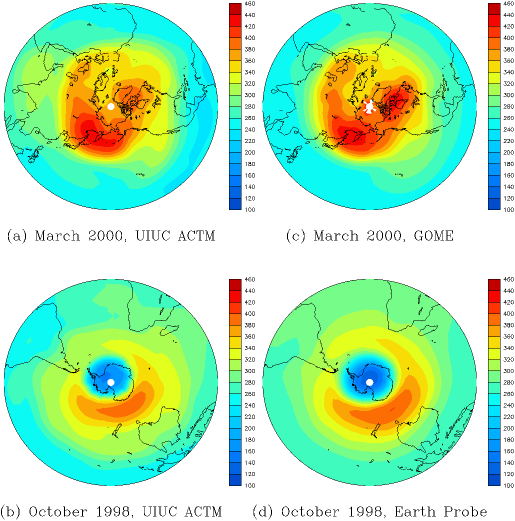 |
| Fig.2 Comparison of the geographical distribution of simulated (a and b) total ozone with observed one by GOME (c) and Earth Probe TOMS (d) satellite instruments in the Northern (March 2000) and Southern (October 1998) Hemispheres. |
To address the above question we have carried out two model simulations with UIUC SCTM: a model run with the actual values of the CFCs concentrations and a model run with the CFCs concentration prescribed according to the WMO (1999) scenario H1 (No Protocol): around 3% annual growth of CFCs constructed for the would-be absence of the Montreal Protocol limitations. These experiments allow to make the direct estimation of the contribution of the Montreal Protocol and its Amendments limitations to the retrieving of ozone level in our days.
Figure 3 presents the year-to-year evolution of the prevented total-ozone destruction (POD) by the MPA in percent since 1996; before this year there are no significant changes. It is clearly seen that the polar regions are the most sensitive to the reduction in the active-chlorine burden. The POD begins to increase noticeably in 1996 over both the northern and southern high-latitudes where the magnitude is about 1.5%. In October 1999 the POD reaches 5% over the South Pole and 2% in March 2000 over the North Pole. The area of the POD gradually spreads out with time and even begins to penetrate into the tropics in 1999. Figure 3 also shows that the reaction to the decrease in active chlorine by the MPA is different in the Northern and Southern Hemispheres. In the Southern Hemisphere there is a noticeable linear time dependence of the POD because in this area, during the winter, the temperature in the lower stratosphere is always low enough to allow the existence of PSCs. In the Northern Hemisphere the time dependence is not linear. During the winters of 1996-1999 the POD is almost the same. The winter of 1996/1997 was relatively cold, but the concentration of active chlorine according to the No-Protocol scenario was small. The winters of 1997/1998 and 1998/1999 were relatively warm, hence heterogeneous processes were not very active. During the winter of 1999/2000 both conditions for the intensification of heterogeneous processes - cold temperature and high stratospheric active chlorine loading - took place, hence a higher POD occurred compared to previous years.
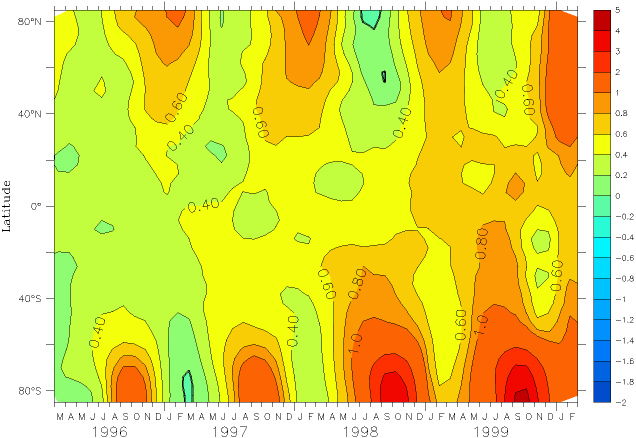 |
| Fig.3 Simulated year-to-year evolution of the total ozone destruction prevented by the MPA according to the No Protocol (H1) scenario. |
Figure 4 displays geographical distribution of the Montreal Protocol effect in percents for March 2000 in the Northern Hemisphere (a, b) and for October 1999 in the Southern Hemisphere (c, d). In the Northern Hemisphere Northern Europe and Central Africa have the biggest beneficial effects of ozone saving up to 2.5% from the Montreal Protocol in spring 2000. In the Southern Hemisphere Antarctic region (5%) and Zambia (2%) were the most sensible regions to chlorine loading in October 1999.
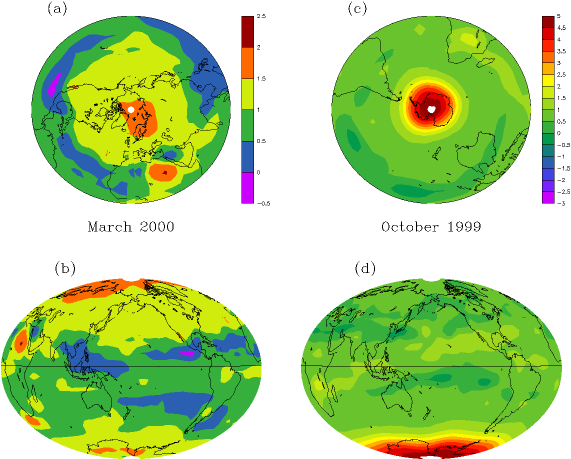 |
| Fig.4 Geographical distribution of the total ozone destruction prevented by the MPA in percent for March 2000 (a and b) and October 1999 (c and d) |
Figure 5 shows the global annual-mean total ozone observed for the satellite era (1979-1999) by pink curve and simulated by the model with (blue curve) and without (red curve) the MPA limitations. It is seen that the global total ozone decreases from 1979 to 1985 and then tends to recover from 1985 to 1989. In 1991 an abrupt total ozone drop occurred as a consequence of the Pinatubo eruption, and thereafter there is a slightly increasing tendency. These positive anomalies cannot be explained by the MPA, because our model shows almost the same positive tendency for the case without the limitations imposed by MPA. Most likely this increasing tendency is caused by the changes in the circulation pattern and/or the decrease of sulfate-aerosol loading following its insertion into the stratosphere in 1991 by the Pinatubo volcano. This indicates that the causes of the pre 1993 ozone decrease should be assessed to elucidate the relative contributions of the anthropogenic influence, circulation pattern and products of volcanic eruptions. Such an assessment requires the development of reanalysis data sets extended at least to the entire stratosphere and covering the time period 1970-2000.
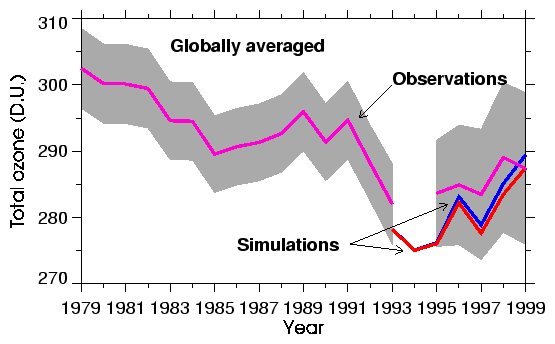 |
| Fig.5 Year-to-year distribution of simulated and observed global annual-mean total ozone for the period 1979 to 1999. Observed values from Nimbus-7, Meteor-3, ADEOS, TOVS, GOME and EP shown by the shaded area. Simulated values shown by the solid line for the actual values of the CFC concentrations and by the dashed line for the No-Protocol (H1) scenario. The observed values is shown by the solid line with asterisks, and the uncertainties of the satellite data are shown by shaded area. The global annual-mean values simulated for the actual values of the CFC concentrations are shown by the solid line with diamonds and for the No-Protocol (H1) scenario shown by the dashed line. |
We may conclude from our first-ever three-dimensional assessment detects the effect of the MPA on atmospheric ozone but shows that CFCs do not play a major role in the observed recent variations of total ozone. For the Northern Hemisphere the effect of active chlorine depends on the meteorological situation and is more noticeable for a colder stratospheric winter. For the Southern Hemisphere the effect mainly depends on the amount of chlorine loading. Using 3D UIUC SCTM with UKMO circulation and temperature fields we are able to estimate the benefits from the Montreal Protocol and its Amendments for specific countries. It should be also emphasized that the uncertainty of our results depends on an ambiguity of the scenario of CFCs concentration grows. Nevertheless, such model estimations devoted to the assessment of the Montreal Protocol and further agreements efficiency are very useful and should be continued in the future to elucidate the practical benefits for different countries from the Montreal Protocol and to perceive gaps in our knowledge about the recent total ozone trends.
Anderson J., Russel III J.M., Solomon S., Deaver L. E. Halogen Occultation Experiment confirmation of stratospheric chlorine decreases in accordance with the Montreal Protocol, J. Geophys. Res., 105, 4483-4490, 2000.
Brune W. H., Toohey D. W., Anderson J. G., Chan K. R. In situ observations of ClO in the Arctic stratosphere: ER-2 aircraft results from 590N to 800N latitude, Geophys. Res. Lett., 17, 505-508, 1990.
Chipperfield M. P. Multiannual simulations with a three-dimensional chemical transport model, J. Geophys. Res., 104, 1781-1805, 1999.
Egorova, T. A. et al. Global distribution of ozone and NOx simulated by UIUC ACTM using the circulation from the UKMO assimilation dataset in CAS/JSC Working Group on Numerical Experiments: Research activities in atmospheric and oceanic modeling. - World Meteorological Organization, Geneva, WMO/TD-No.987, Rep.No.30, 2000.
Engel A., Schmidt U., Mckenna D. Stratospheric trends of CFC-12 over the past two decades: Recent observational evidence of declining growth rates, Geophys. Res. Lett., 25, 3319-3322, 1998.
Farman J. C., Gardiner B. G., Shanklin J. D. Large losses of the total ozone in Antarctica reveal seasonal ClOx/NOx interaction, Nature, 315, 207-210, 1985.
Froidevaux, L. et al. Variations in the free chlorine content of the stratosphere (1991-1997):Anthropogenic, volcanic, and methane influences, J. Geophys. Res., 105, 4471-4481, 2000.
Montzka S. A. et al. Decline in the tropospheric abundance of halogen from halacarbons: Implications for stratospheric ozone depletion, Science, 272, 1318-1322, 1996.
Montzka S. A. et al. Present and future trends in the atmospheric burden of ozone-depleting halogens, Nature, 398, 690-694, 1999.
Müller J.-F., Brasseur G. IMAGES: A three-dimensional chemical transport model of the global troposphere, J. Geophys. Res., 100, 16,445-16,490, 1995.
Rozanov E. V., Zubov V. A., Schlesinger M. E., Yang F., Andronova, N. G. The UIUC 3-D Stratospheric Chemical Transport Model: Description and Evaluation of the Simulated Source Gases and Ozone, J. Geophys. Res., 104, 11,755-11,781, 1999.
Rozanov E., Zubov V., Schlesinger M., Yang F., Andronova N. Three-Dimensional Simulations of Ozone in the Stratosphere and Comparison with UARS Data. Phys. Chem. Earth, 24, 459-463, 1999
Scientific Assessment of Ozone Depletion: 1998, World Meteorological Organization, Geneva, Rep. No.44, 1999.
SPARC Implementation plan, Stratospheric processes and their relation to climate. - World Meteorological Organization, Geneva, WCRP-105, WMO/TD-No.914, 1998.
SPARC News Letter No.14, pp.28-31, January, 2000.
Stenchikov G.L. et al., Radiative forcing from the 1991 Mt.Pinatubo volcanic eruption, J. Geophys. Res., 103, 13,837-13,857, 1998.
Swinbank R., O'Neill A. A stratosphere-troposphere data assimilation system, Mon. Wea. Rev., 122, 686-702, 1994.
Back to
| Session 1 : Stratospheric Processes and their Role in Climate | Session 2 : Stratospheric Indicators of Climate Change |
| Session 3 : Modelling and Diagnosis of Stratospheric Effects on Climate | Session 4 : UV Observations and Modelling |
| AuthorData | |
| Home Page | |